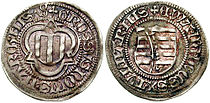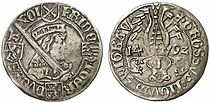Zwickau Mint
The Zwickau mint, founded in 1440 during the reign of Elector Friedrich II (1428–1464) and his brother Sigismund (from 1440 Bishop of Würzburg ), was in operation until 1493 with interruptions. Differences of opinion between the Ernestine Elector Johann the Steadfast (1486 / 1525–1532) and the Albertine Duke Georg the Bearded (1500–1539) led temporarily between 1530 and 1533 to the reopening of the disused mint. After the reestablishment of the mint community , the Wettins relocated the mint to Schneeberg in 1534 .
history
Already in the Bracteatic era , when Zwickau was subject to imperial bailiffs, a document from 1297 named Heinrich the Mint or Mint Master among the city councilors . However, there is no direct reference to an imperial mint.
Dime
In the mint opened in 1440 in Zwickau, under the direction of the mint master Hans Tromschmidt, common shield groschen of the Elector Friedrich II., The Meek with Landgrave Friedrich the Peaceful (1406–1440) and with his brother Wilhelm in the goodness of 20 pieces on the Rhenish Guilder struck. After the death of Landgrave Friedrich von Thuringia in 1440, the Freiberg Mint still minted until 1442 and the Zwickau Mint until 1441 in smaller quantities in small amounts shared by Frederick II and his brother Wilhelm.
From the Saxon coin reform of 1444, the new coin was the Jew's head groschen ( Oberwähr ), the Wettins minted shield groschen ( Beiwähr ) of the mints Freiberg, Gotha , Saalfeld and Zwickau with continuously reduced silver content . The following Münzordnungen to stabilize the currency Grosch had another Grosch types Horn dime , Spitz penny (in their time, among other things silberin dimes called) half sword dime, Bart dime , pay tribute and finally the Schreckenberger dime result. All these types of grosch, except horn groschen and interest groschen, were also expressed in the Zwickau coin. The horn groschen were struck in the Freiberg and Colditz mints from 1465 and in the Wittenberg mint in 1466/1467 . The interest groschen required for the introduction of the taler currency were minted by the Schneeberger and Leipzig coins from 1496 . After the coin reform of December 1474, the pointed groschen were minted in the Zwickau Mint, which was reopened in 1475 and which had been inactive since 1470. Mint master Conrad Funke had them minted in the former high currency to 20 pieces in the Rhenish guilder (0.937 f.). In addition to the Freiberg, Colditzer, Leipziger and Gotha mints, the Zwickau mint also minted half pointed groschen. Since these groschen only contained 5 lots of silver (0.312 f.), They were heavier and larger than the whole pointed groschen. They were to be minted in a quality of 40 on the Rhenish guilder.
- Zwickau Groschen:
Elector Ernst , Duke Albrecht , Duke Wilhelm III. (1465-1482), Pointed Groschen (14) 78, Mmz. Shamrock, Zwickau Mint
Elector Friedrich III. , Johann and Duke Georg, beard groschen 1492, Mmz. Kleeblatt, Zwickau and Schneeberg (Krug 1878)
Coin location
The location of the mint is mentioned in the chronicle of the district town of Zwickau from 1839:
- […] The mint workshop itself, however, was relocated in the city to the handsome Rangesche private house on the Holzmarkt, that is, the still so-called coin no. 96 on Klostergasse, where the sovereign mint master Conr. Funke (from 1478 to Augustin Horn) except gold gold (from Hungarian gold), whole and half pointed groschen, whole and half sword groschen, interest groschen, lion and other pfennigs, and pennies, and almost all of them were struck from pure silver [...]
The interest groschen mentioned in the chronicle are the Zwickau beard groschen struck from 1492 until the closure of the mint in 1493 at 21 groschen on the Rhenish guilder, equal to the Schneeberg interest groschen minted from 1496. The designation of the beard groschen as an interest groschen was common. Gold guilders were not struck in Zwickau, but in the Leipzig mint under the mint masters Hans Stockart and Heinrich Stein.
Thaler time
Saxon coin separation
As a result of differences of opinion, from 1530 to the end of 1533 there was a separation between the Ernestine and Albertine minters Johann the Constant and George the Bearded, the so-called Saxon coin separation . The "Bergmünzstätte" Zwickau, which was temporarily reopened in 1530, minted from this time onwards for the Elector Johann (1525–1532) after a lighter monetary standard , while Duke Georg in the mints Freiberg, Leipzig and Annaberg AFTER THE OLD SCRAP AND GRAIN (quality designation on the Reverse of the coins of George). The common Schneeberg mint on Ernestine territory was closed.

As early as 1531, the state estates of both minters decided in the so-called Grimmaischen power ruling that Duke Georg had to cede his claim to half of the Schneeberg mint to the elector. For this purpose, the Zwickau Mint is to be moved back to Schneeberg. In 1534, the former coin community came into force again under Elector Johann Friedrich [1532–1547– (1554)] and Georg the Bearded. As a result, the Wettins relocated the Zwickau mint back to Schneeberg.
In the period from 1530 to 1533, the Zwickau mint minted three-penny pieces (three), half-groschen, groschen (interest groschen), horror berries, ½ thaler and thaler.
Coin location
The mint, which had been closed since 1493, was reopened in 1839 in Saxonia. Saxon Patriotic Museum mentions the mint building and its laying:
- [...] An electoral mint for the minting of the silver obtained from the mines near Schneeberg was established in 1530 in the castle of Zwickau and there on May 1st of this year money was minted in whole and half thalers and in small types of coin. But the mint was moved to Schneeberg as early as 1534 [...].
The Münzstraße in the city center still reminds of the time of the Zwickau mint; the road connecting the main market and the Kornmarkt.
Tipper and luffing time
In the time of money falsification, the tipper and wipper era , the monopoly of the Dresden Mint was broken with the establishment of tipper mints. In Zwickau, too, from 1621 to 1622, under the mint master Adam Prellhoff, Mmz. Anker and three swans started the production of interim or tipper coins , which is being operated on an ever larger scale . That was groschen, Doppelschreckenberger, 4, 8, 20, 30, 40 and 60 groschen pieces ( Kippertaler to 60 groschen).
As a coin image for the new coins, an angel was used on the obverse as a shield holder for the Saxon coat of arms and on the reverse for the 60 groschen tipper coins, two angels holding three coats of arms. The great similarity with the high-quality Schreckenberger or angel groschen minted in Saxony and Thuringia from 1498 to 1571 should make the Ursual coins popular in Electoral Saxony. For this purpose they were also used under the same name. The mint could not be objected to, because they were not taler coins or their parts, but groschen pieces, i.e. land coins, which did not have to comply with the imperial coinage system. The smallest coins, i.e. one-sided copper pennies, were produced by the Grünthal copper hammer .
Mint master of the Zwickau mint
| Mint master | from | to | Mintmaster's mark | comment |
|---|---|---|---|---|
| Hans Tromschmidt | 1440 | 1441 | Cross, six-pointed star | |
| Juerge Silberborner | 1442 | 1449 | X ( St. Andrew's Cross), six-pointed star | from 1445 also mint master in the Sangerhausen mint (?) |
| Conrad Funcke | 1469 | 1470 | six-pointed star | |
| Conrad Funcke | 1475 | 1477 | Crescent moon between two points | |
| Hans Passek | 1477 | 1478 | Crescent moon | |
| Augustin Horn | 1478 | 1481 | Shamrock | |
| Augustin Horn | 1482 | 1485 | Shamrock | Mint master in Zwickau and Schneeberg |
| Augustin Horn | 1490 | 1493 | Shamrock | Mint master in Zwickau, Schneeberg and Langensalza |
| Sebastian Funcke | 1530 | 1533 | X (St. Andrew's Cross) | Mint moved to Schneeberg in 1534 |
In the periods without information, the coin operation was interrupted.
See also
Individual evidence
- ^ Friedrich Albert von Langenn: Duke Albrecht the courageous, progenitor of the royal house of Saxony 1838, p. 573
- ^ Paul Arnold: Walther Haupt and his "Sächsische Münzkunde" , p. 54
- ↑ Walther Haupt: Sächsische Münzkunde , p. 31
- ↑ Gerhard Krug: The Meissnisch-Saxon Groschen 1338-1500 , Berlin 1974, p. 177
- ↑ Dr. Emil Herzog: Chronicle of the district town of Zwickau, first part. Topography and Statistics , Zwickau 1839, p. 201
- ↑ mcsearch.info: Elector Johann (1486 / 1525-32), Taler undated, Zwickau (minted after a lighter coin base)
- ↑ Eduardt Pietzsch and Comp .: Saxonia. Museum for Saxon Fatherland Studies , Fourth Volume, Dresden 1839, p. 13
- ↑ mcsearch.info: Elector Johann Georg I., 60 tipper groschen 1622, Zwickau
- ↑ Walther Haupt: Sächsische Münzkunde , p. 136
literature
- Walther Haupt: Saxon coinage , German. Verlag der Wissenschaft, Berlin 1974
- Paul Arnold: Walther Haupt and his “Saxon Coin Studies” . In: “Numismatic Notebooks”. No. 20, Dresden 1986
- Gerhard Krug: The Meissnian-Saxon Groschen 1338–1500 , Berlin 1974
- Julius Erbstein , Albert Erbstein : Discussions in the field of the Saxon coin and medal history when listing the Hofrath Engelhardt'schen collection , Dresden 1888
- Heinz Fengler; Gerd Gierow; Willy Unger: transpress Lexikon Numismatics , Berlin 1976
- Otto F. Müller: Otto Merseburger Collection comprising coins and medals from Saxony, sales catalog , Leipzig 1894




